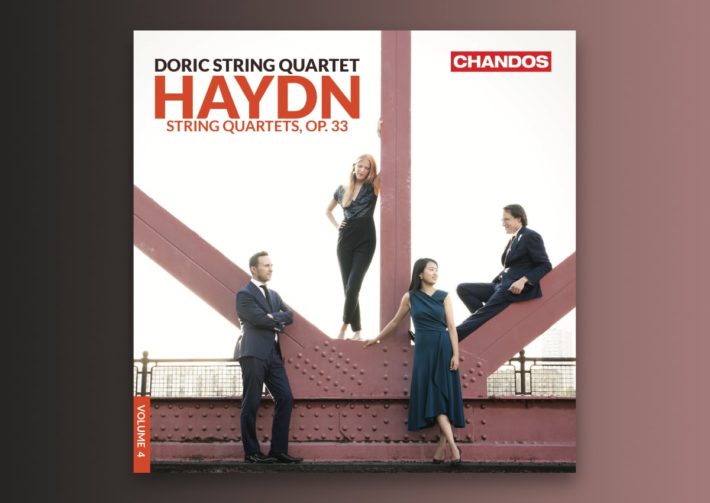The fourth installment of the Doric Quartet’s Haydn String Quartet cycle marks a change of personnel to the second violin, with Ying Xue replacing Jonathan Stone, but with no noticeable change to the balance. The current trend with many groups, including the Dudok on their Haydn Op. 20 albums (review), is to hybridize period bows with modern rather than gut strings. The Doric have a set of specially commissioned classical-style bows, which they used in their previous Haydn Op. 20, 64 and 76 releases as well as in their Mendelssohn recording. The bows deliver a slightly smaller sound, but with a refreshing transparency and warmth, even more than previous volumes.
The fourth installment of the Doric Quartet’s Haydn String Quartet cycle marks a change of personnel to the second violin, with Ying Xue replacing Jonathan Stone, but with no noticeable change to the balance. The current trend with many groups, including the Dudok on their Haydn Op. 20 albums, is to hybridize period bows with modern rather than gut strings. The Doric have a set of specially commissioned classical-style bows, which they used in their previous Haydn Op. 20, 64 and 76 releases as well as in their Mendelssohn recording. The bows deliver a slightly smaller sound, but with a refreshing transparency and warmth, even more than previous volumes.
The tempo choices bring excitement in the quicker movements and onward drive in the slower ones. They take risks to diligently propel and project the music forward as in the opening movement of No. 1 in B minor, where they create a growing urgency. Or in the fourth quartet’s opening movement, when the brisker tempo emphasizes the vivacious character and brings a bold interpretation. The broader movements maintain an elegance throughout; The slimmer tones become more noticeable here, but the tempi prevent this from sound thin. Sophisticated phrasing sustains interest, as in the particularly impressive second movement of the D major quartet.
Related Classical Music Reviews
- Review: Haydn – String Quartets Op. 20 – Dudok Quartet Amsterdam
- Review: “All Shall Not Die” – Haydn String Quartets – Quatuor Hanson
- Review: Mozart – String Quintets K. 515, 516 – Quatuor Van Kuijk
Haydn replaces the minuets with scherzos in this opus, however, in several instances Haydn doesn’t completely throw off the cloak of the minuet, writing something very-dance like. The Doric acknowledge this by keeping a sense of movement, elegance and triple meter strong, as in No. 4 in B-flat’s Scherzo. Whereas in the fifth quartet’s Scherzo, they bring a different energy and vibrancy which is intrinsically strong, and executed with greater vigor than the Lindsays.
Vibrato is used sparingly and with expressive versatility. The lack of vibrato in the first quartet emphasizes the darker qualities, but is used sensitively in the second quartet to soften the sound. The players are also not afraid to use the occasional portamento, mostly to emphasize Haydn’s humor, as in the E-flat quartet. Rubato is used as sensitively too, just where and when the music commands it, giving the music a natural spontaneity. Their choice and execution of the dynamics allow for drama with strong and bold contrasts in all movements, but especially in the C and D major quartets (No. 3 and 6), with nuanced and delicate detailing.
Recorded in Potton Hall, Suffolk, England, the acoustic adds just enough atmosphere. The balancing is good overall, with a weightier bass which makes the cello and viola sound more distinctive. The booklet contains well-written and interesting notes about the opus, which really does aid to set the works in their musical context. The Doric Quartet may be fussier than both the Lindsays or Quatuor Mosaïques, but they bring a unique style, poise and sophistication. They certainly have distinctive things to say in op. 33, which is no small feat. An important Milestone in the Doric’s ongoing Haydn cycle and an essential listen for any chamber music fan.

Haydn – String Quartets Op. 33, No. 1-6
Doric String Quartet:
Alex Redington – Violin
Ying Xue – Violin
Hélène Clément – Viola
John Myerscough – Cello
Chandos Records, CD 20129 (2)
Recommended Comparisons
Lindsays | Mosaïques | Aeolian | Kodály
[the_ad_group id=”226″]
Read more classical music reviews or visit The Classic Review Amazon store
Follow Us and Comment:
Get our periodic classical music newsletter with our recent reviews, news and beginners guides.
We respect your privacy.









